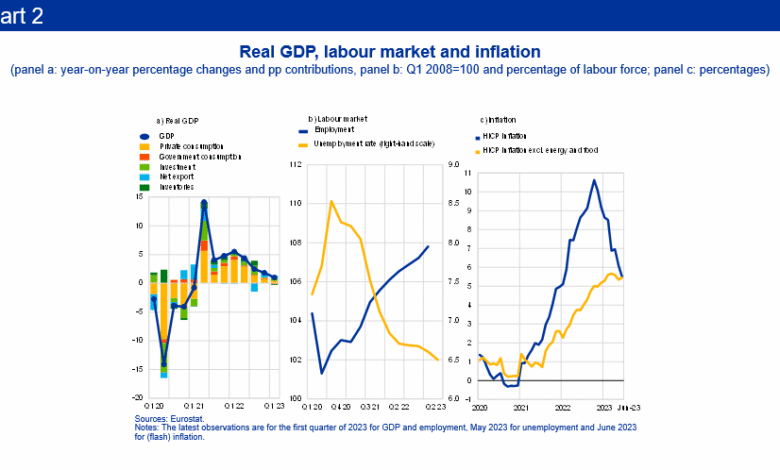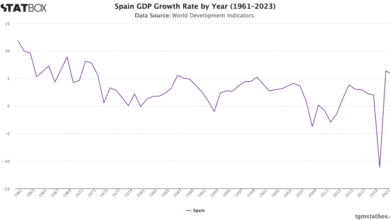Inflation Outlook Tumbles to Pre-Tariff Levels: Survey Insights

The inflation outlook has recently shifted, showing a decline to pre-tariff levels, as highlighted by the latest University of Michigan survey. This survey indicates that consumer sentiment has started to recover, rising 1.8% from June, reaching a score of 61.8, which is its highest since February. However, despite these gains, concerns about future inflation remain, particularly driven by fears of tariff-induced inflation impacting the economy. The findings reveal that the expectations for US inflation rates, both in the short and long term, have tumbled, prompting economic forecasts to become more cautious. As consumers navigate the changing landscape of prices, the interplay between tariffs and inflation continues to influence their outlooks on the economy and their purchasing power.
The forecast for rising prices appears less daunting than it once did, as evidenced by recent consumer insights reflecting an easing concern about inflation. With a careful examination of market sentiment, it seems the anticipated surge in pricing pressures has moderated, reminiscent of previous economic cycles. Consumer attitudes, as documented in surveys like the University of Michigan’s, highlight a growing assurance among individuals regarding economic conditions, despite lingering uncertainties. Tariff impacts have previously cast a shadow over inflation expectations, but the recent data suggest a stabilizing trend in personal finance optimism. Overall, the trajectory of inflation and its implications for consumer confidence remain a focal point for analysts and economists alike.
Understanding the Latest Inflation Outlook
The latest results from the University of Michigan survey reveal a significant shift in consumer sentiment regarding inflation, marking a hopeful turn in economic forecasts. As inflation concerns dwindle, the latest figures show a notable decline in projected inflation rates, reflecting a broader sense of stability among consumers. The one-year inflation outlook dropped to 4.4% from June’s 5%, highlighting a growing confidence that prices will stabilize rather than escalate as they had feared during higher tariff periods.
This dramatic reduction in inflation expectations can be attributed to various factors, including the fading impact of tariff-induced inflation that had previously driven fear among consumers. As these tariffs were introduced, economists and consumers alike anticipated steep price hikes, contributing to significantly heightened inflation forecasts. The current outlook suggests that consumers are beginning to adjust their views, as both one- and five-year predictions are falling to levels not seen since February, encouraging a more positive long-term economic perspective.
Impact of Tariff-Induced Inflation on Consumer Sentiment
Despite the recent downturn in concerns over tariff-induced inflation, consumers remain cautious, indicating a lingering awareness of potential price surges. The University of Michigan survey underscores this sentiment, as it details how tariff-related policies have previously instigated a volatile environment for consumers. Although the figures have improved, the fear of inflation still looms, suggesting that consumers are not yet entirely comfortable with the current economic climate.
The initial shock and subsequent adjustments to U.S. inflation rates have shaped consumer sentiment significantly. From an inflationary perspective, the introduction of tariff policies led to unprecedented uncertainty, pushing predicted inflation rates to historic highs. The retraction of these fears, as highlighted in the survey, signals a shift but also demonstrates the fragility of consumer confidence in the face of economic policies that can have rapid and unforeseen consequences.
Analysis of Consumer Sentiment Trends
The current University of Michigan survey results provide a critical lens through which we can analyze consumer sentiment trends. The 1.8% increase in overall sentiment reflects an encouraging bounce-back, as consumers express a renewed sense of optimism in economic conditions. This uptick is essential, especially as businesses look to navigate the choppy waters of changing tariff policies and inflation expectations.
However, even with positive consumer sentiment, the stark drop in inflation outlook suggests that there is still considerable concern about future price stability. The current conditions index showcases a slight increase, juxtaposed with falling expectations, which underscores a complex emotional landscape for consumers. As they cautiously navigate their financial decisions amid shifting economic forecasts, businesses must adapt to these evolving sentiments to address consumer needs effectively.
The Relationship Between Inflation Forecasts and Economic Stability
The interplay between inflation forecasts, such as those reported by the University of Michigan survey, and broader economic stability is critical for policymakers and businesses alike. As inflation predictions drop to their lowest levels since pre-tariff announcements, there is a resounding call for confidence in the market. This shift indicates a potential momentum toward economic recovery, prompting analysts to reassess earlier economic forecasts that suggested prolonged inflationary pressure.
In a climate marked by economic uncertainty, these lowered inflation expectations can foster an environment ripe for investment and growth. When consumers feel reassured about the trajectory of inflation, they are more likely to spend and invest, which propels economic activity. Furthermore, the recent survey highlights the necessity for continuous monitoring of consumer sentiment, as it will inevitably influence U.S. inflation rates and guide future economic policies.
Evaluating Long-Term Inflation Expectations
While the immediate outlook on inflation appears encouraging with declines in one- and five-year forecasts, it is crucial to evaluate the long-term implications of these insights as captured by the University of Michigan survey. With current projections showing levels above December 2024’s readings, it is evident that consumers still regard inflation risks with skepticism. Understanding the nuances of these expectations will be vital in shaping future fiscal policies.
Moreover, mapping long-term inflation expectations against consumer sentiment helps paint a clearer picture of economic health. The survey indicates that while immediate fears may have diminished, the shadow of inflation remains, as consumers weigh the potential impacts of tariffs and global economic shifts on their financial futures. This layered perspective is essential as we navigate the post-tariff era, catering to informed policy-making and strategic business operations.
Consumer Sentiment and Its Social Implications
The relationship between consumer sentiment and broader social implications cannot be overstated. According to the latest University of Michigan survey, as inflation fears abate, there is a corresponding increase in confidence that can lead to enhanced social stability. Consumers’ willingness to spend is indicative of their overall economic well-being, which, in turn, can influence societal dynamics such as employment rates and community prosperity.
Despite the currently improved sentiments, lingering concerns about potential inflation spikes can create an environment of cautious enthusiasm among consumers. This duality affects how households approach not only spending but also saving and investment strategies. In this light, understanding consumer sentiment trends and their social implications will be vital for businesses that aim to align their strategies with the communities they serve, fostering a more resilient economic environment.
The Effect of Economic Forecasts on Consumer Behavior
Economic forecasts, including those indicated in the University of Michigan survey, have profound effects on consumer behavior and decision-making processes. The declining outlook on inflation, from 6.6% in May to 4.4% in July, signals a shift in consumer confidence, prompting a reevaluation of spending patterns. As consumers feel more optimistic about the future, especially when they believe inflation is under control, there’s a propensity for increased spending which can drive economic growth.
Conversely, if inflation expectations were to rise again, we might see a significant retrenchment in consumer spending. The survey’s findings remind us that expectations shape reality; consumers adjust their behaviors based on perceived economic conditions. Thus, businesses must remain attuned to the fluctuations in economic forecasts, as they directly influence consumer trust and willingness to engage in financial transactions.
Future Trends in U.S. Inflation Rates
Predicting future trends in U.S. inflation rates requires a nuanced understanding of the interplay between various economic indicators and consumer sentiment, as observed in the recent University of Michigan survey. With optimistic sentiment rising slightly while inflation outlooks are at historic lows, the immediate future seems promising. Analysts are cautiously optimistic that these trends may lead to a sustained period of lower inflation rates, promoting broader economic stability.
However, the possibility of external shocks, such as renewed tariff announcements, poses a risk to this budding optimism. Should inflation expectations begin to climb again, the resultant impact on consumers could dampen spending and affect market dynamics. Therefore, it is imperative for economists and policymakers to monitor these trends closely, ensuring that strategies remain adaptable to safeguard against inflation’s unpredictable nature.
Navigating Tariff Policies and Inflation Rates
Navigating the complex landscape of tariff policies and their impact on inflation rates is crucial in light of the findings from the University of Michigan survey. As tariffs have historically influenced market behaviors, the recent dip in inflation expectations suggests that consumers may be adjusting their perceptions of these policies. Understanding consumer sentiment in this context is essential for policymakers, as it provides insight into the effectiveness of current tariff approaches and their socio-economic implications.
Furthermore, as businesses anticipate potential changes stemming from new tariffs, they must consider the long-term effects of inflation rates on their pricing strategies. The fluctuations observed in consumer sentiment can dictate market trends and influence purchasing behaviors. By staying informed on such developments, businesses can better position themselves to meet consumer demands while remaining economically viable in a shifting landscape influenced by tariff and inflation concerns.
Frequently Asked Questions
What does the latest University of Michigan survey indicate about the inflation outlook?
The latest University of Michigan survey indicates a significant drop in the inflation outlook, with one-year expectations falling to 4.4% and five-year expectations to 3.6%. This represents the lowest levels since February 2025, reflecting consumers’ reduced concerns about tariff-induced inflation.
How has consumer sentiment changed in relation to the inflation outlook?
Consumer sentiment increased slightly to 61.8, according to the University of Michigan survey. Despite this increase, the inflation outlook suggests a cautious optimism, as consumers remain wary of potential price increases.
What impact did tariff-induced inflation have on the inflation outlook in 2025?
Tariff-induced inflation had a marked impact on the inflation outlook in 2025, especially following announcements of tariffs by the Trump administration. Initially, expectations surged, but recent surveys show a decrease in inflation fears, returning outlooks to pre-tariff levels.
What are the economic forecasts for US inflation rates based on the latest survey?
The economic forecasts for US inflation rates, as derived from the University of Michigan survey, show a decline in inflation expectations. Currently, the one-year inflation outlook is at 4.4%, down from higher readings earlier in the year, indicating reduced immediate inflation concerns.
How do the inflation expectations from the University of Michigan survey compare to previous years?
Inflation expectations from the University of Michigan survey show a lowered outlook compared to 2024, with current figures for one- and five-year forecasts dropping significantly from their highs. This indicates a shift in consumer sentiment regarding long-term inflation risks.
| Aspect | Details |
|---|---|
| Overall Sentiment | Increased by 1.8% from June to 61.8, the highest since February |
| Inflation Outlook (1-Year) | Decreased to 4.4%, down from 5% in June and 6.6% in May |
| Inflation Outlook (5-Year) | Decreased to 3.6%, down by 0.4 percentage points from June |
| Consumer Sentiment Trends | Reading down 6.9% year-over-year and 16% since December, despite a higher current condition index |
| Current Conditions | Index was 6.5% higher compared to the previous year, reflecting improved perspectives despite inflation fears |
Summary
The inflation outlook has notably dropped to pre-tariff levels, as highlighted in the latest University of Michigan survey. The survey indicates that consumer sentiment has risen slightly, yet there remains a cautious approach towards future inflation. While the one- and five-year inflation forecasts have reached their lowest since February, concerns persist regarding potential price increases due to tariffs and other economic pressures. Despite some improvement in current conditions, the outlook reflects the ongoing uncertainties in the economic landscape.



